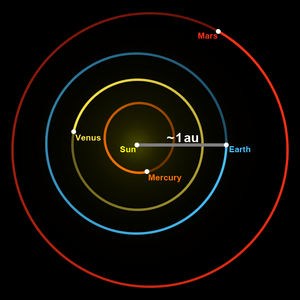Astronomical unit facts for kids
Quick facts for kids Astronomical unit |
|
|---|---|

The grey line indicates the Earth–Sun distance, which on average is about 1 astronomical unit.
|
|
| General information | |
| Unit system | Astronomical system of units (Accepted for use with the SI) |
| Unit of | length |
| Symbol | au or AU |
| Conversions | |
| 1 au or AU in ... | ... is equal to ... |
| metric (SI) units | 1.495978707×1011 m |
| imperial & US units | 9.2956×107 mi |
| astronomical units | 4.8481×10−6 pc 1.5813×10−5 ly |
The astronomical unit (AU) is a special unit of length. It helps us measure huge distances in space. Think of it as a cosmic ruler!
It is based on the Earth's orbit around the Sun. One AU is roughly the average distance between the Earth and the Sun. This distance is about 150 million kilometers or 93 million miles.
Astronomers use the AU to talk about distances within our Solar System. It makes these vast numbers much easier to understand. For example, instead of saying "Mars is 225 million kilometers from the Sun," we can say "Mars is about 1.5 AU from the Sun."
Contents
What is an Astronomical Unit?
An astronomical unit, or AU, is a way to measure how far apart things are in space. It's like using "steps" to measure a room. But for space, our "step" is the distance from Earth to the Sun.
The Earth's path around the Sun is not a perfect circle. It's an ellipse, which looks like a slightly squashed circle. The AU is defined as the average distance of the Earth from the Sun along this elliptical path.
Why Do We Use AU?
Space is incredibly vast. Distances between planets and other objects are huge. Using kilometers or miles would mean writing out very long numbers. For example, Neptune is about 4.5 billion kilometers from the Sun.
Using astronomical units makes these numbers much simpler. Neptune is roughly 30 AU from the Sun. This is much easier to read and compare. It helps scientists and students grasp the scale of our Solar System.
How Big is One AU?
One AU is exactly 149,597,870,700 meters. That's almost 150 million kilometers! Light, which travels incredibly fast, takes about 8.317 minutes to cover one AU.
Here are some examples of distances in our Solar System using AU:
- Mars is about 1.4 AU from the Sun.
- Jupiter is roughly 5.2 AU from the Sun.
- Saturn is about 9.5 AU from the Sun.
- Uranus is around 19.2 AU from the Sun.
- Neptune is roughly 30 AU from the Sun.
- The dwarf planet Pluto is about 39 AU from the Sun.
This shows how quickly distances grow as you move further away from the Sun.
Images for kids
See also
 In Spanish: Unidad astronómica para niños
In Spanish: Unidad astronómica para niños


